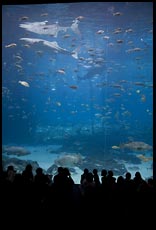Site Home : Aquariums : One Article
 Aquarium maintenance is guided by the following principles:
Aquarium maintenance is guided by the following principles:
Step 2 is to run a refrigerator icemaker water line to the back/top of the tank. The water will be turned on and off by a solenoid valve and a timer. So you can set the fresh water to flow in for, say, 1 hour per day. If you terminate the water line with a sprayer that limits the flow rate you'll be sure that (a) the water is getting aerated before introduction to the tank, (b) dissolved gasses in the tap water have a final chance to escape, and (c) a known amount of fresh water is being introduced to the tank every day.
The water in Cambridge, Massachusetts, comes out with a very high pH of 9.5. The water department achieves this high pH by adding soda ash. This keeps the water from pulling lead from old plumbing in the ancient houses prevalent here. Most African Cichlids would probably adapt to this pH quite nicely but what they won't like is the fact that the soda ash deteriorates upon encountering light. Thus a freshly-filled aquarium will exhibit a pH of 9.5 but will have drifted down to a neutral 7 within one day. If you were then to perform a 100 percent water change, the fish would be subjected to a shocking pH change from 7 up to 9.5. The "10 percent per day" plan avoids these sudden shocks. The pH will rise a bit with the introduced fresh water but not enough to affect the fish.
What about the tapwater's chloramine? Can the fish handle this slow-to-breakdown poison? There is no need to experiment. A carbon filter from www.multipure.com, for example, will remove more than 95 percent of the chloramine and just about anything else nasty in the tap water. So stick a carbon filter in line with the freshwater supply and the fish should be quite happy. Note that the Multi-Pure filters are good for treating about 750 gallons. So they should last for 2.5 months when treating water for a 100-gallon aquarium on the 10 percent per day plan. New cartridges are about $50 each.
Most of the components for constructing a system like this are available from John Maier at www.jehmco.com, (800) 521-6258.
Immediately after draining the tank down to the 40-percent mark, I begin to refill the tank with a mix of hot and cold tap water, at roughly the same temperature as the tank. I use Seachem Prime to neutralize the chloramine. When the tank gets up to 60 or 70-percent full, I shut the water off and walk away for an hour. This gives the fish some time to adapt to the pH increase caused by the introduction of the fresh Cambridge tap water. Then I come back to the tank and finish filling it with tap water. The shock of adapting to the water change is thus spread out over an hour. People who do commercial aquarium maintenance tend to frown on such large water changes but I think this is partly because they wouldn't be able to allocate an hour or two of clock time to the refilling of a single tank. In any case most African Cichlid experts and breeders swear by large water changes, sometimes as much as 90 percent per week.